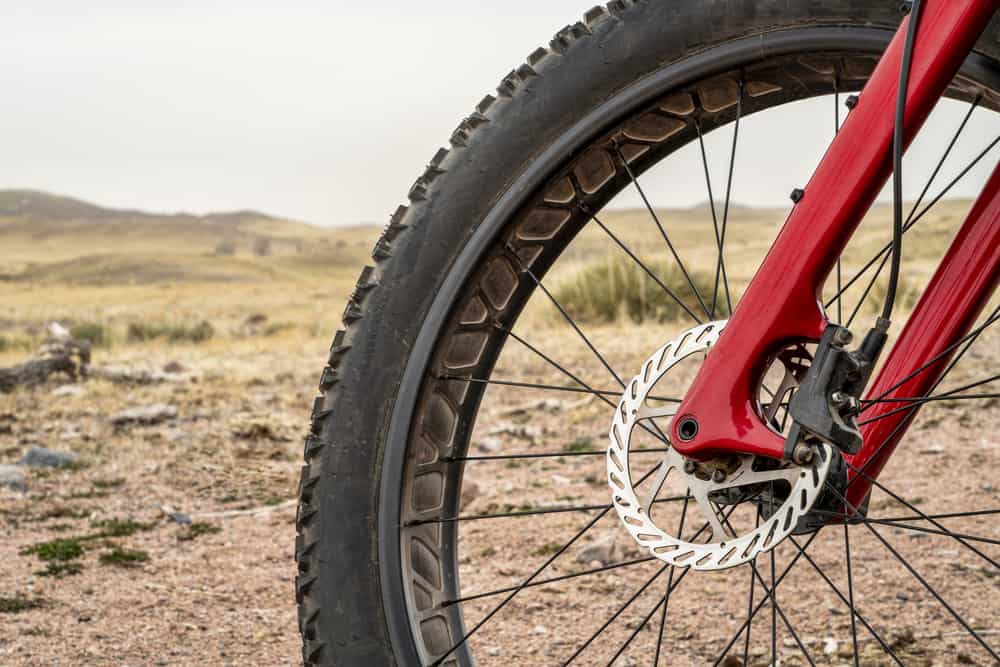The answer is rather no. The bike and rider weight is distributed over a larger tire contact area. For that reason, fat tire bikes are suitable for sand, mud, rocks, snow, wet roots, and other terrains that you would have problems with other bikes.
Outside of those conditions, regardless of the rider’s weight, they are not better than any other bike.
The rest of this article will go over the benefits of using fat tires in the context of heavy riders. It will also discuss other factors like frame material determining a bike’s weight capacity.
What is A Fat Tire Bike?
A fat tire bike has quite wide tires, between 3,8 and 5 inches. Its design, wider tires, and lower tire pressure allow riding on soft, unstable terrain, so endurance and strength are prioritized over speed.
Due to lower tire pressure, a fat tire bike provides higher comfort, although it is not equipped with a suspension system. Conversely, you can not develop higher speed due to higher rolling resistance.
Wider tires require wider rims, wider hubs, and forks.
Even so, they can easily accommodate 200 to 250 pounds. So, if you’re overweight (up to 400 pounds), you’ll still be able to find tires that suit your needs.

Do Fat Bikes Hold More Weight
Fat bikes are more robust. Consequently, they have a higher capacity weight limit, so they are a good choice for overweight riders.
But you have to prioritize your needs; why are you buying a bicycle? If the reason is speed, you should look for a road bike that you upgrade with custom wheels that can hold more rider’s weight.
If you want to ride on roads and gravel terrain, you should consider a mountain bike since it creates less rolling resistance. The tires are narrower with higher air pressure, so the contact patch with the ground is smaller.
Described factors enable mountain bike to have higher speeds with less energy consumption. And the acceleration is also faster.
Why Can Some Bikes Hold More Weight
For normal-sized riders, the main question is not the bike’s capacity but rather which type of bike to buy. But if you are oversized or taller, you should know what to look for when deciding on a bicycle.
Three main components affect what weight the bike can carry.
Bike Wheels
The bike wheels need to be strong to bear the rider’s weight. Generally, a wheel with smaller diameter rims uses shorter spokes, and such a wheel is structurally stronger. A wheel of 26 or 27,5 inches for an overweight rider will be more useful. Besides the diameter of the wheel, it also depends on the material made. Also, a number of spokes are important, and you should buy a wheel whit at least 32 spokes.
Bike Tires
Thicker tires provide more stability and comfort. Wider tires can run on lower air pressure which makes them soft. And a soft tire can absorb vibrations and other shocks from the road.
Fat tire bikes can absorb shocks in terrain easier than slim tires can. Companies that manufacture such tires usually target people who like to bike on uneven and rugged terrain. Heavy riders aren’t their target audience. They accidentally end up catering to this demographic as well.
Bike Frame
For heavier riders, the bike frame should be sturdy and durable. A bike frame made from steel or steel alloy is stronger but heavier to handle. You can also consider an aluminum alloy bike frame, which is lighter but less durable.
Most fat tire bikes have big heavy frames. These tend to be both heavier and more robust than slimmer bikes.
Consequently, heavier riders should be prepared to invest in high-quality bikes that will last a long time.
Brakes
Inertia and gravity mean that heavy riders will take longer to stop than others.
So, when deciding what bike to purchase, it is crucial to look into efficient brake systems.
Mechanical disc brakes are always good because they don’t cause wear and tear on the rims. So, you don’t have to do maintenance as much as you otherwise would.

If you overload your bike, then you eventually be signs such as:
- the trouble with tire pressure,
- spokes breaking,
- bend rims.
What are the other benefits of having a fat tire bike?
Besides the fact that fat tire bikes are stronger, they can hold more weight and could be a good choice for overweight people to start cycling. Fat tire bike can offer:
- easy to ride and is great for a beginner
- you can ride on any surface, but you will enjoy on off trail
- due to fat tires, you do not need to worry about air pressure. Lower pressure will help you to ride on more rough terrain
- fewer problems with broken spokes and warped rims
- fat bikes are safer because top speed is low. You can turn slow so you can handle any obstacle on the road
- fat bikes look fabulous, and you can enjoy riding everywhere
Some frequent questions about fat tire bikes
Are fat bikes harder to ride?
No, they are not harder to ride. With a fat tire bike, you can ride on paved surfaces and softer and rough terrain. However, it takes more effort to move because they are heavy.
Are fat tire bikes easier to balance?
Yes, because they have wider, flatter tires that provide more stable balance and grip. Better grip is possible because a fat tire bike has a larger surface area.
Hence fat tire bikes are more suitable for beginners.
Are fat bikes good for trail riding?
Yes, they are suitable, but they are even more suitable for softer surfaces. However, a fat tire bike will provide more stability and comfort for rough trail biking but will not be the best choice for riding uphill.